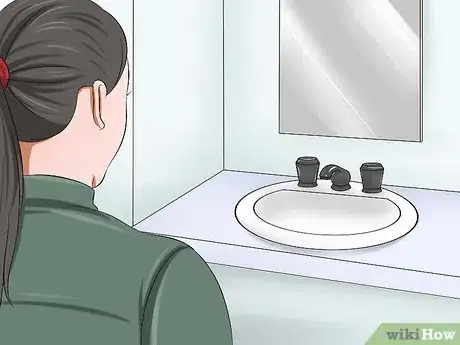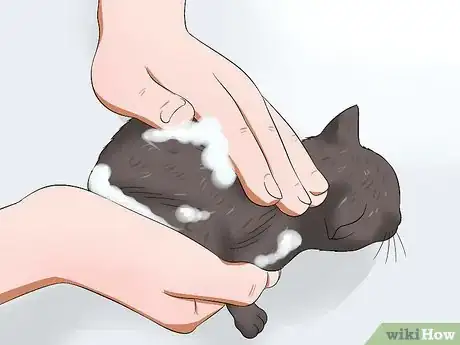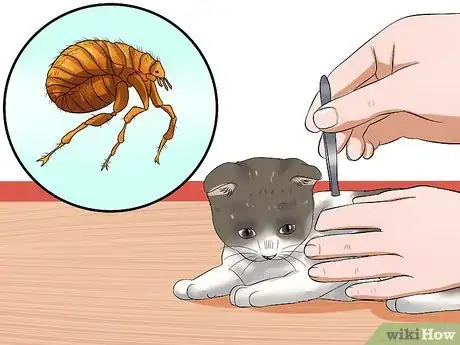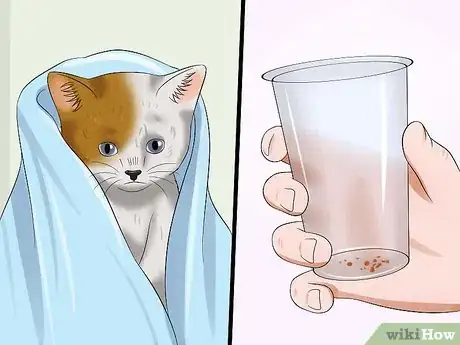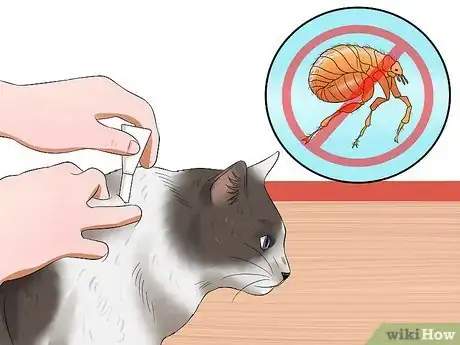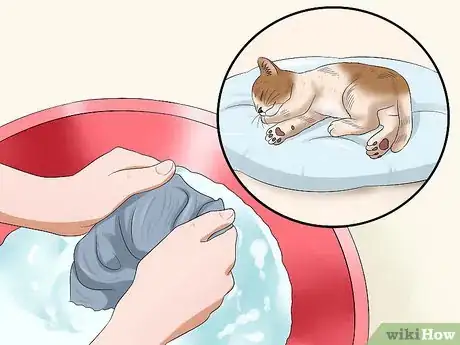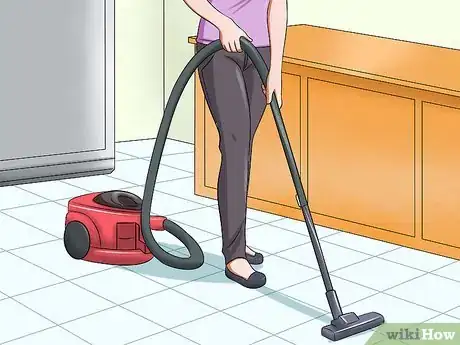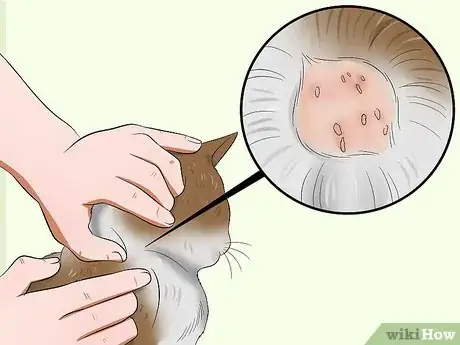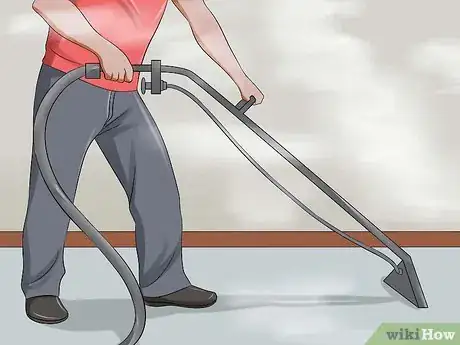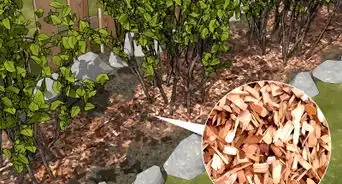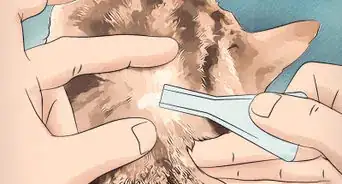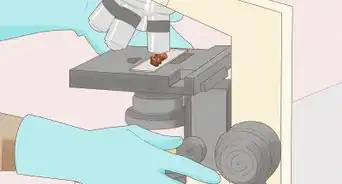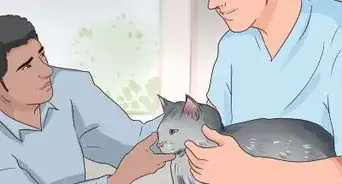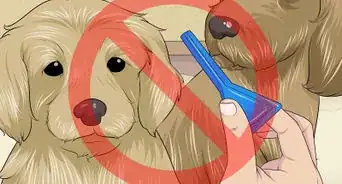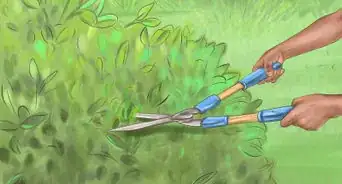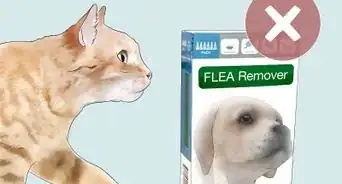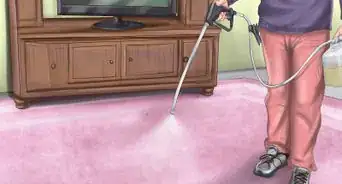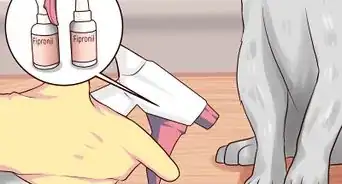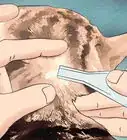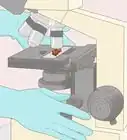This article was co-authored by Pippa Elliott, MRCVS. Dr. Elliott, BVMS, MRCVS is a veterinarian with over 30 years of experience in veterinary surgery and companion animal practice. She graduated from the University of Glasgow in 1987 with a degree in veterinary medicine and surgery. She has worked at the same animal clinic in her hometown for over 20 years.
wikiHow marks an article as reader-approved once it receives enough positive feedback. In this case, 100% of readers who voted found the article helpful, earning it our reader-approved status.
This article has been viewed 77,284 times.
As soon as your kitten is born, it is possible for it to get fleas. Unfortunately, in very young kittens, regular flea medications are too strong to use and will cause harm to your kitten. Ignoring the fleas is not an option, as they can grow in number and cause serious health issues for your kitten. You will need to take action, properly bathing your cat and eliminating the fleas by hand to help your little friend recover.
Steps
Bathing Your Kitten
-
1Prepare your space. Before you begin removing fleas form your kitten, you will want to prepare the space you are going to be using. This will make the task easier, not only for yourself, but for your kitten as well.[1]
- You may want to wash your kitten in the sink as it can be easier to control your kitten.
- You will need a flea comb handy.
- Have your soap nearby. Dish soap is fine to use, however, avoid any strongly scented soaps. Flea and tick soaps will likely be too strong to use on your kitten.
- Make sure you have a towel to dry your kitten off with.
- Prepare a cup of warm salt water to drown the fleas you remove.
- Fill the sink with warm water.
- Grab some tweezers to pluck the fleas off your kitten.
-
2Place your kitten in the water. Once you have prepared your space and have collected all the items you will need, you can start to bathe your cat. The first step is to simply place your kitten in the warm water you have prepared. Make sure the water is a safe and comfortable temperature for your kitten before putting it in.[2]
- Keep your kitten's head dry.
- Make sure the rest of the fur has been completely soaked.
Advertisement -
3Apply soap and rinse cat off. After initially placing your cat in the bath, remove it and start to apply the soap. Gently rub the soap into its fur and make sure you cover all areas of the body, including the head. Once you have applied the soap thoroughly, rinse your kitten off completely, expect for its head.[3]
- Be careful not to get any soap in your kitten's eyes.
- Fleas will try to avoid the water and may swarm your kitten's head, as it is still dry. This is normal and will help you find the fleas when you start removing them.
-
4Remove fleas. Now that your kitten has had its bath, you can begin looking for and removing fleas from it. Use both the flea comb and the tweezers to find and eliminate the fleas from your kitten's fur. Be very thorough as you search and try to remove every last one of them.[4]
- Brush your cat with the flea comb to easily remove a great number of fleas.
- Pluck off the fleas with your tweezers if your flea comb misses any.
- Put any fleas you find in your cup of warm salt water, which will cause them to drown.
-
5Dry your kitten off and dispose of fleas. Chances are your kitten is going to be upset by this point so dry it off and let it get back to playing. Make sure your kitten is also kept away from any of its old bedding or other areas, such as carpeted rooms, that could still harbor fleas. [5]
- Make sure your kitten is warm enough after the bath. Dry it off completely and place it in a warm room.
- Take the cup of dead fleas and flush them down the toilet to make sure they are gone.
- If you think any other cats might still have fleas, keep them away from your freshly cleaned kitten.
Preventing Further Flea Infestations
-
1Apply flea treatments to older cats. If you have any cats in your home that are old enough for medical flea treatments, apply them to help protect your kitten. By making it impossible for fleas to infest your older cats, your kitten will be less likely to suffer from fleas again.[6] [7]
- Cats under 6 weeks of age cannot receive chemical treatments for fleas.
- Cats aged 14 weeks and older, or which are 2 lbs, may take Comfortis for fleas.
- Talk with your veterinarian to learn which flea medications might be appropriate for your cat.
-
2Wash anything the kitten uses. Fleas can wait and hide on any object your kitten used, such as bedding or fabric, and will return to your kitten if they are able. Take away this possibility by thoroughly cleaning these items and killing any fleas that remain.[8]
- Wash your kitten's bedding on high heat to help kill any fleas that might be hiding.
- You may want to simply dispose of any old bedding or cloth toys.
-
3Clean your environment. Because fleas are so small, they can easily hide in a number of places in your home. Flea eggs can also lay dormant for a time and later hatch, potentially causing another round of bathing and flea removal for your kitten. You will have to diligently clean these areas to make sure that there are no fleas left hiding in your home.[9] [10]
- Vacuum all rugs and carpets in your home. You may want to sprinkle borax on them before vacuuming.
- Wash all of your own sheets, blankets and pillows. Fleas can hide in fabric and will need to be removed.
- If the environment isn't cleaned properly, your cat will likely become infested again.
-
4Watch your kitten for signs of fleas. After removing the fleas from your kitten and keeping the environment free of fleas, you will need to monitor your kitten for any new infestations. As you play with your kitten, take a moment to look around its fur for any returning fleas or signs of their bites.[11]
- Constant scratching may be a sign that your kitten has fleas.
- Excessive grooming can be another indication that your kitten is suffering from fleas.
- Run your flea comb through your kitten's fur occasionally. Drop anything that was collected onto white paper. If you notice small, black specks, this can indicate the presence of fleas.
-
5Consider using pest control products. If your flea infestation is particularly bad or proving difficult to manage, you may want to use insecticides in your home. These kill fleas and their larvae, preventing further trouble from the ones currently living in your house. Some pest control methods can be quite disruptive, such as a "fogger", so make sure it is necessary before you use one.[12] [13]
- Bring every person and all pets outside if you use a "fogger" or "bomb" type of pest control. These products are toxic and can kill your pets if exposed directly to them.
- When looking for any pest control product, find one that is labeled as an "IGR". This stands for insect growth regulator, and will make it impossible for the fleas in your home to reproduce.
- If you are using a spray bottle style pest control method, make sure to cover all carpets and rugs. Remember to spray under furniture and rugs as well.
- Allow the house to fully ventilate and let the insecticide dry completely before letting your pets back into the targeted areas.
Warnings
- Fleas can pose serious health risks to your kitten and require your attention.⧼thumbs_response⧽
- Be careful what products you use on young kittens. There are some products which have been tested on young kittens and found to be safe, but some may be harmful. Talk to your vet or check the packaging to see if a product is licensed for use in young kittens.⧼thumbs_response⧽
Things You'll Need
- Mild, unscented, soap.
- Towels.
- Tweezers.
- Flea Comb
- Cup with warm salt water.
References
- ↑ http://www.petful.com/pet-health/flea-medicine-for-kittens/
- ↑ http://www.catsofaustralia.com/kitten_fleas.htm
- ↑ http://www.petful.com/pet-health/flea-medicine-for-kittens/
- ↑ http://www.catsofaustralia.com/kitten_fleas.htm
- ↑ http://www.petful.com/pet-health/flea-medicine-for-kittens/
- ↑ http://www.catsofaustralia.com/kitten_fleas.htm
- ↑ http://www.petful.com/pet-health/flea-medicine-for-kittens/
- ↑ http://www.vetstreet.com/dogs/flea-and-tick-prevention
- ↑ http://www.vetstreet.com/dogs/flea-and-tick-prevention
About This Article
If you need to get rid of fleas on a kitten that’s too young for topical ointments, you’ll have to comb the fleas out of its fur with a flea comb. Bathe the kitten with mild dish soap and warm water, but avoid getting its head wet. Brush the cat with the flea comb, then dip the comb in a cup of warm salt water after each pass. This will drown the fleas, so they can’t jump back onto the kitten. If you need to, you can also use tweezers to remove any fleas that you didn’t get with the flea comb. Afterward, dry your kitten with a soft towel, and dispose of the salt water by flushing it down the toilet. For tips from our Veterinary co-author on preventing the fleas from returning, like treating older cats with medication, read on!
